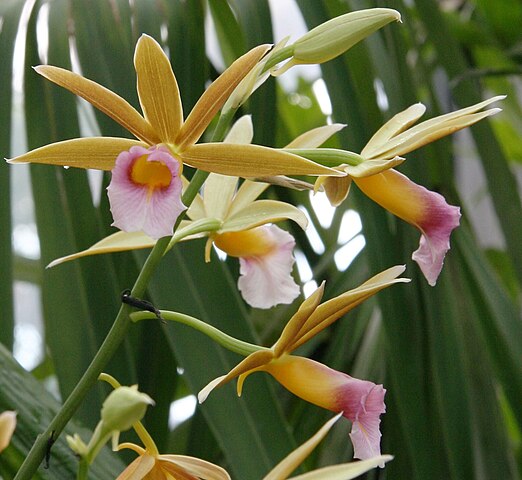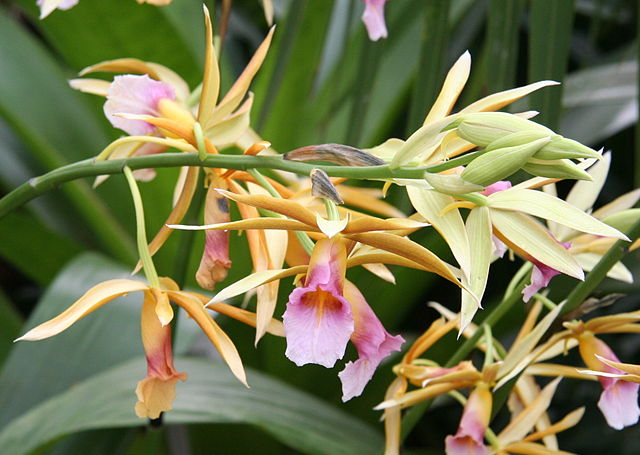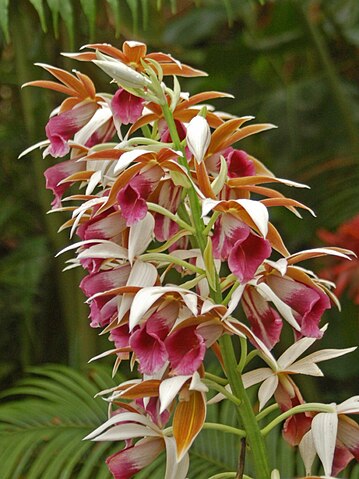The Nun’s orchid (Phaius tankervilleae) is named for its curved upper sepal and petals that are white on the back side, resembling a nun’s cap. Nun’s Orchids, also called Swamp Orchids, are popular, easy-to-grow orchids and are considered ideal for a beginner. Nun’s orchid produces a few large, thin pleated leaves which can grow to a height of about three feet.
Nun’s orchid produces a few large, thin pleated leaves which can grow to a height of about three feet. The inflorescence (flower cluster) arises from a pseudobulb (a short, fleshy shoot found in most orchids) or a rhizome(an underground horizontal plant stem).
Essentials


Soil composition and ph levels for Nun’s Orchid plants
Soil composition and ph levels are important factors to consider when growing Nun’s Orchid. The ideal soil composition for Nun’s Orchid is sandy loam with a pH level of 6.0-7.0. Soils that are too alkaline or too acidic can cause the plant to become stunted or yellowed.
Additionally, Nun’s Orchid requires good drainage, so soils that retain moisture for extended periods of time are not ideal. If you are unsure of the composition of your soil, a simple pH test can give you a better understanding of its nutrients and acidity levels.
Watering Nun’s Orchid plants
Nun’s Orchid is a species of orchid native to Central America. It is a terrestrial orchid that grows in open, sunny areas at elevations of 1,000-2,000 meters. The plant blooms from May to June, producing yellow flowers with purple spots. The nun orchid or nun‘s orchid, is so called because of its hooded flowers.
The plant prefers humid conditions and requires moist soil to thrive. Nun’s Orchid is easy to grow and is a good choice for beginners. It can be propagated by division or by seed. Watering Nun’s Orchid is an evergreen perennial and will bloom for many years with proper care.

More about the flowers…
Nun’s orchid produces a few large, thin pleated leaves which can grow to a height of about three feet. The inflorescence, which resembles flower clusters, arises from a pseudobulb (a short, fleshy shoot found in most orchids) or a rhizome(an underground horizontal plant stem). The showy, fragrant flowers grow on the stalks of the plant.
The blooms are white with purple spots and a yellow center, and they appear in late spring or early summer. Each flower measures about 3 inches across and lasts for about a week.
Do Nun’s Orchid plants produce fruits?
Nun’s Orchid does not produce fruits. This orchid is native to southeastern China and is named for the shape of its flowers, which resemble the habit worn by Catholic nuns. However, it is an interesting and beautiful plant that makes an excellent addition to any garden.
These exceptional orchid plants are unisex, meaning they produce either showy and colorful male flowers or less-impressive, greenish-white female flowers. The sex of flowers produced depends on the conditions in which the plant matures. Sometimes a plant living in moderate conditions will produce both male and female flowers.

Propagation of Nun’s Orchid plants
Propagation of Nun’s Orchid can be achieved asexually, via division of the pseudobulbs or by seed. Propagation by division is the most common method, as it is the easiest and quickest method with the highest success rate. To propagate by division, simply divide the pseudobulbs, ensuring each has at least 3-4 leaves. Allow the divisions to callous for a few days before potting in well-drained soil.
Propagation by seed is a slower process, taking anywhere from 2-3 years to achieve blooming size plants. Seeds should be sown on the surface of a well-drained mix and kept moist but not wet. High humidity is also essential for successful germination. Once germination occurs, seedlings should be transplanted into individual pots and grown under cool to intermediate conditions. With proper care and attention, propagation of Nun’s Orchid is relatively easy and rewarding.
Pests and diseases in Nun’s Orchid plants
Pests and diseases affecting Nun’s Orchid plants include the following:
Aphids: These small, sap-sucking insects can cause stunted growth and distortion of new leaves. They can also transmit viruses between plants. Control aphids by blasting them off with a strong jet of water, or by using an insecticide.
Gray mold: This fungal disease causes a gray or brown mold to form on leaves, flowers, and stems. It can kill young plants, and make older plants more susceptible to stress and other problems. Control gray mold by removing affected plant parts, and by increasing air circulation around the plants. You can also use a fungicide to prevent the disease from spreading.
Spider mites: These tiny pests are difficult to see with the naked eye, but they can cause extensive damage to leaves and flowers. They suck out plant juices, which can cause stippling, discoloration, and eventually death of the plant tissue. Control spider mites by using a powerful jet of water to knock them off the plant, or by using an insecticide. You may also need to increase humidity around the plant to discourage these pests.
Irritation to pets from Nun’s Orchid plants
Irritation to pets from Nun’s Orchid can cause skin and coat problems. The plant contains chemicals that can cause an allergic reaction in some animals. If your pet comes into contact with the plant, wash the area with soap and water. You may also want to contact your veterinarian. Pets may also experience gastrointestinal upset if they eat the plant.
Symptoms include vomiting, diarrhea, and abdominal pain. If your pet consumes the plant, contact your veterinarian immediately. Irritation to pets from Nun’s Orchid can be serious, so it is important to seek medical attention if your pet is exposed to the plant.

Growing Nun’s Orchid plants in containers and pots
Growing Nun’s Orchid in containers and pots is a great way to add color and life to any space. Here are a few tips to help you get started:
– Choose a pot that is slightly larger than the root ball of the plant. This will give the roots plenty of room to grow.
– Be sure to use a well-draining potting mix. Nun’s Orchids like their roots to be moist, but they will not tolerate soggy conditions.
– Place the pot in an area that receives bright, indirect light. Too much direct sun will scorch the leaves, while too little light will cause the plant to become leggy.
By following these simple tips, you can enjoy watching your Nun’s Orchid thrive indoors for years to come.
Caring for Nun’s Orchid plants
Caring for Nun’s Orchid is not difficult, but there are a few things to keep in mind. Here are some tips:
– Water regularly, but make sure the potting mix is always moist, not soggy.
– Feed every two weeks with a balanced liquid fertilizer during the growing season.
– Caring for Nun’s Orchid in winter is easy: just reduce frequency of watering and doses of fertilizer.
– Repot every two or three years in spring, using a well-draining potting mix.
Companion plants for Nun’s Orchid plants
When choosing companion plants, it is important to consider the needs of the Orchid and select plants that will complement its growth. There are a few companion plants that work well with Nun’s Orchids. Some of these include Ferns, Ivy, ,Philodendrons, Pothos, Spider plants, etc. Each of these plants has different benefits that can help the Nun’s Orchid to thrive.
For example, ferns help to create a humid environment, which is ideal for orchids. Ivy and philodendrons are both fast-growing vines that can provide support for the orchid’s stems.
Spider plants are known for their air-purifying properties, and they also produce small white flowers that look similar to the Nun’s Orchid.
Planting and spacing for Nun’s Orchid plants
Planting and spacing for Nun’s Orchid: Plant 12″-18″ apart, in rows 18″-24″ apart. Plant in a location that receives full sun to partial shade and has well-drained soil. Space plants so that mature plants will be about 3′ apart. Mulch around plants to help retain moisture and keep roots cool. Apply fertilizer once a month during the growing season.
Water regularly, Keeping the soil evenly moist but not soggy. When planting, it is important to loosen the roots and soak them in water for an hour before planting. This will help the plant to establish itself quickly.
Best time for growing Nun’s Orchid plants
The best planting time for Nun’s Orchids is in the spring when the weather is warm and the days are longer. The plants need plenty of sunlight to bloom, so they should be placed in a sunny spot in the garden. They also prefer well-drained soil, so make sure to avoid areas that are prone to flooding or puddling.
Nun’s Orchids are not difficult to care for, but they do need regular watering and fertilizing to thrive. Once they are established, they will bloom annually, typically in late spring or early summer. With a little care, these beautiful flowers will bring enjoyment for many years to come.
Benefits of Nun’s Orchid plants
Nun’s orchid is a tropical plant that is native to the Caribbean and South America. Nun’s orchid is a popular ornamental plant, and it has a number of benefits.
The plant is drought tolerant and does not require much water once it is established. The plant is resistant to pests and diseases. The plant does not require much fertilizer and hence is easy to care for. Further, the plant attracts hummingbirds and butterflies.
How long do Nun’s Orchid plants take to grow?
Nun’s orchids take 3 to 5 years to mature and flower. Plants grown from seed will take longer to flower than those grown from divisions. Flowering usually occurs in the fall. Nun’s orchids are native to Central America and their natural habitat is in the tropics. They prefer warm temperatures and high humidity.
Nun’s orchids can be grown outdoors in zones 10-11. If you live in a colder climate, they can be grown indoors as houseplants. When growing Nun’s orchids indoors, it is important to provide them with bright, indirect light and high humidity. An east-facing window is ideal. You can increase the humidity around your orchid by setting the pot on a tray of pebbles filled with water.

Be sure to keep the water level below the bottom of the pot so that the roots do not become waterlogged. Nun’s orchids like to be kept moist but not wet. Water them when the top inch of the soil feels dry. During the winter months, reduce watering somewhat but do not allow the plant to go completely dry. Fertilize Nun’s orchids monthly with a balanced fertilizer diluted to half strength.
Feed them more frequently during the spring and summer when they are actively growing. After flowering has occurred, reduce fertilizing to once every other month until new growth appears again in the springtime. New growth usually occurs in late winter/early spring in most parts of the country. When new growth appears, resume monthly fertilizing until flowering occurs again in late summer or fall.
When can Nun’s Orchid plants be repotted?
Nun’s Orchids can be repotted when the roots have outgrown the pot, typically every two to three years. When repotting, use a well-draining potting mix and a pot that is only slightly larger than the current one. Water thoroughly after repotting and avoid fertilizing for six weeks. Nun’s orchids prefer to be slightly pot-bound, so don’t re-pot more often than necessary.
| Nun Orchid | |
| Water | Best to water once per week during the growing season; reduce it to once per 10 days; keep the substrate moist when the weather is dry. |
| Soil ph | 5.5-6.3 |
| Sunlight hours | Plant it in a place of plenty of light; likes full sun; but not direct sunlight; more than 6 hours sunlight per day is advised. |
| Pests and Diseases | Aphids sucks the plant juice and infests the plant distorting its growth; black rot, botrytis, bud blast, caterpillars, cold damage are other diseases. |
| Temperature | Can withstand a low temperature of 35 deg F; lower than that level may damage the plant; average room temperature of 55-60 deg F (18-20 deg C) is favourable. |
| Soil composition | The plant likes a good peat-based, well-drained organic soil mix; a plant that is fairly adaptable different soil compositions. |






